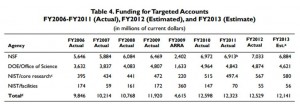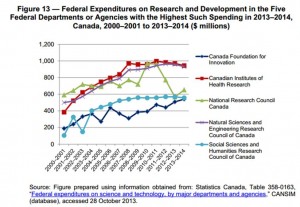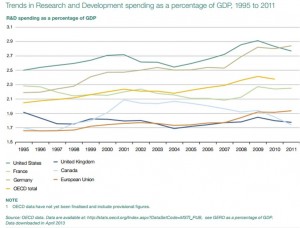While money can’t solve all of our economic and innovation-related problems, the figure below, from a Canadian Parliamentary Standing Committee on Finance report, highlights a rather interesting, if not concerning, trend. In particular, aggregate government spending on science and technology through Canada’s five main spending agencies has flatlined over the past 8 years. The Canada Foundation for Innovation has seen as 33% increase since a previous peak in ’06, but these gains are more than offset by cuts to the National Research Council.
Now without getting into the details as to why this investment pause has occurred, nor its impacts, what’s perhaps most interesting and perhaps better yet, most worrying for Canadians, is that this pause happens whilst our biggest competitors ramp up R&D investment.
See for example US funding for R&D through its biggest non-defense agencies (this is a great report). Spending over the 2006 – 2012 period is up by a third. To be sure, the 2013 budget sequestration and ongoing debates over the US Federal debt have cause a slowdown and decrease in 2013 spending, however the trend since 2006 is clear. It lies in large part in former President George W. Bush’s American Competitiveness Initiative which aimed to double funding for all federal science and engineering research by 2016. The timeline for this doubling has been extended an extra year to 2017 but the goal, and previous action, nonetheless remains significant.

And beyond the US, the world’s biggest R&D spender, how do we fare? Not very well, and increasingly poorly. See this chart based on OECD data on aggregate domestic R&D spending. It’s shocking how Canadian R&D trends compare to Germany, the US and even France.
This last OECD graphic should send politicians and policy makers scurrying for a plan. Without dipping into too much hyperbole, if Canada is going to compete in a global economy, we need to think carefully about how we fund research and development. As noted in a previous post, finding ways to increase business R&D is at the top of list. But so too is Federal and Provincial leadership on R&D funding, no matter whether it occurs in government labs, academia or private enterprise.
Ultimately, if we’re not willing to see R&D as a public good that leads to long-term economic gains, than we’re not going to compete, let alone win, in a increasingly competitive global race for innovation, employment and growth.
Here’s hoping 2014 brings better policy on this topic.

